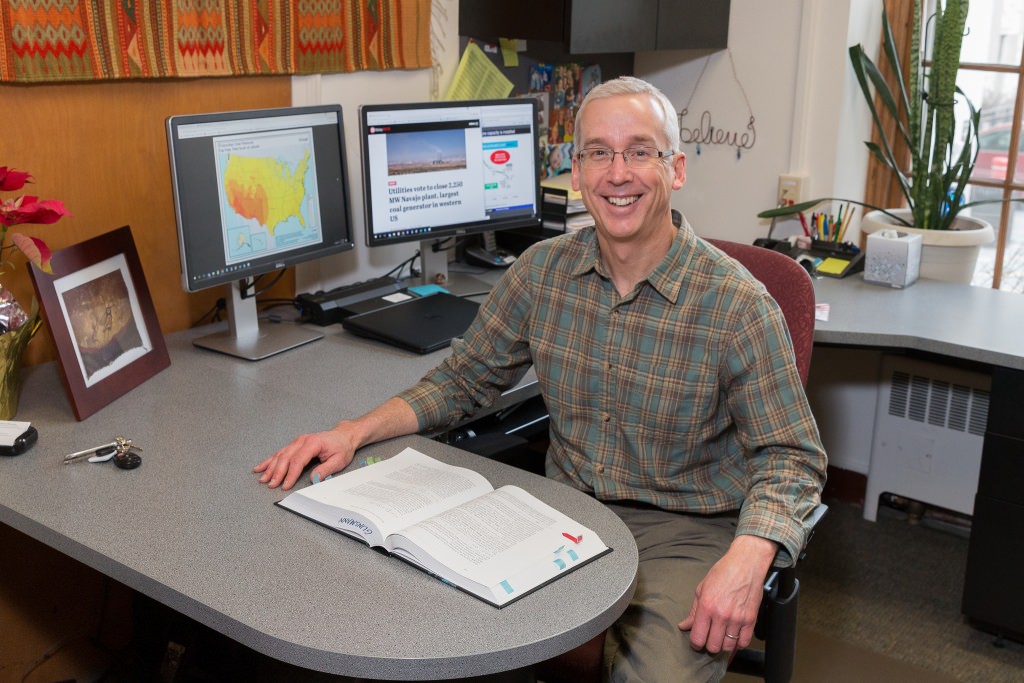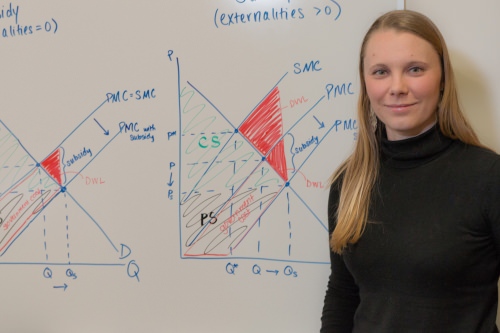Fast-track master’s preps graduates for jobs in energy analysis

Bill Provencher founded the Resource and Energy Demand Analysis (REDA) program in the College of Agricultural and Life Sciences CALS. Sevie Kenyon, UW–Madison CALS
For decades, American energy companies have tried to persuade customers to use less energy. Using giveaways and various other financial incentives, utilities have promoted new light bulbs, miserly showerheads and smart thermostats.
Part of the goal has been to reduce emissions of carbon dioxide and other pollutants. But another incentive hits utilities on the bottom line. Electric utilities must buy enough generation capacity to meet peak demand, which explains their interest in programs, for example, to taper the use of air conditioning on hot summer afternoons.
No matter what happens in Washington, energy analysis will remain a growing field, says Bill Provencher, a professor of agricultural and applied economics at the University of Wisconsin–Madison. Graduates are also prepared for jobs forecasting the demand for energy, and there will always be a need for that, he says. “In terms of moving toward renewables, the horse is out of the barn. For some states, federal changes may make a difference, but for others, not much.”
The programs sound good, but do they work? That difficult analysis has been neglected, and the answers won’t come solely from classical supply-and-demand economics, says Provencher.

Bethany Glinsmann, program coordinator, Resource and Energy Demand Analysis (REDA) program in the College of Agricultural and Life Sciences CALS. The goal of the program is to prepare students for careers as energy and resource analysts Sevie Kenyon, UW–Madison CALS
Last year, Provencher founded the Resource and Energy Demand Analysis (REDA) program in the College of Agricultural and Life Sciences at UW–Madison.
“Understanding why people do or don’t sign up and carry through with these programs involves new economic theory and methods, such as behavioral economics” he says. “Good intentions are not enough; results depend on whether energy is actually saved.”
REDA is a one-year route to a master’s degree, and last year’s graduates are already at work in the energy industry. Michael Francis, for example, works for the U.S. Energy Information Administration, and Emily Morris works at New York City utility company Con Ed.
“One of my responsibilities is benefit-cost analysis of the Brooklyn-Queens demand management program, which has been able to postpone a $1 billion substation construction project for 10 years,” Morris says. “Con Ed has to invest in providing the energy in other ways, or encouraging enough customers to cut back on their usage. I look at whether the program is cost-effective.
“I would not be here without REDA.”
Francis says his REDA experience included going to as many as 20 seminars led by experts in the field. “Today, I was reading a report at DOE, and realized that I had personally met some of the authors during REDA,” he says. “After the program, you will find connections in whatever city you end up working in, no matter what specific segment of the energy industry you are in.”
In previous work for a large energy consulting firm, Provencher has been surprised at the difficulty of identifying qualified applicants for analyst positions. The analytical tasks are complex, he adds. Imagine that a utility with 50,000 residential customers starts a demand reduction program — perhaps it will give four high-efficiency LED light bulbs to any customer on request. To prove whether that significantly reduces energy demand in the next year, the utility must consider how many customers get the bulbs, changes in economic activity (people may use more electricity when they feel prosperous), and feedback to the customer (does the utility measure consumption and congratulate them for acting “green”?), to name a few factors.
Crunching those numbers and reaching supportable conclusions is no easy matter, Provencher says, but it’s exactly what the REDA program is designed to do. In one year, graduates get a grounding in econometrics — think of it as the meshing of economics with statistics — and the energy industry. They meet analysts, consultants, executives and economists in the field, and complete a “capstone” project with a local or distant utility or firm, where they must base conclusions on real customer data.

An energy analysis app for a smart phone. Sevie Kenyon, UW–Madison CALS
A major part of the class is learning rigorous statistical analysis, using an open-source program called R. “R is a statistical program language that I had never heard of before, but now I use it daily,” says Morris, at Con Ed. “It’s been a huge tool for me.”
REDA is a “terminal” master’s degree, which is meant to prepare students for their careers rather than serve as a steppingstone for a Ph.D., but that limitation does not seem to bother grads. “I was looking to go down the public policy route, but I was not convinced of the value of spending two years on the degree,” says Justin Margolies, now an analyst at Wisconsin Energy Conservation Corp. in Madison. “I realized that REDA would be a better, more focused route.”
The one-year master’s program is particularly attractive to people with “green” values, says Bethany Glinsmann, program coordinator. “Some states and utilities are starting to pay attention to climate change and reducing their carbon footprint, but they need to make hard choices: ‘Given our limited set of resources, we want to be sure we are spending money in the most efficient manner.’ And that’s where program evaluation comes in. Did it work? Or could we find a way to spend these dollars in a more effective way?”
By applying statistical analysis of human behavior to energy — a field previously dominated by engineers and technology — REDA offers a more realistic and insightful way to assess the success or failure of demand reduction programs, says Margolies. “The energy industry was historically built by engineers, and they used engineering algorithms to estimate the available savings from technology — say, installing an LED or a new air-conditioning unit — but we have been a little weak on verifying the savings. They did not take into account the behavioral element: People may not use the technology, or it may not be installed correctly. Those are the questions we are now equipped to answer.”
Several students now in the program praise it.
Drew Blumenthal, who is expected to graduate in June, says he’s impressed by how much real industry data is used in the program. “We are using data that a company has gathered over a long period to get real-world examples of the things we will be doing after graduation,” he says.
Trace O’Rorke, another student graduating in June, says the program “offers technical expertise that environmental study majors would not necessarily have, while those coming from an economics background will learn how to apply their skills to energy and the environment.



